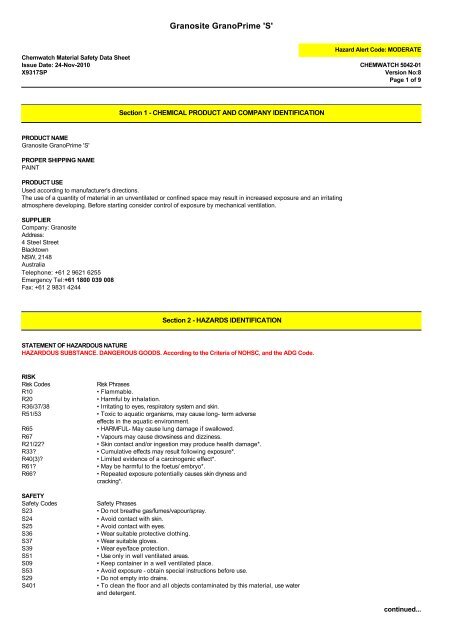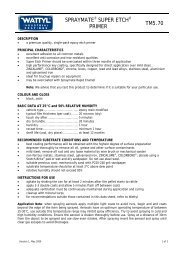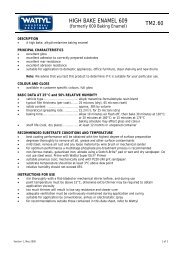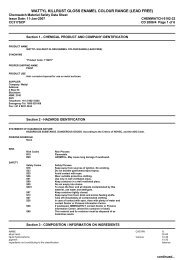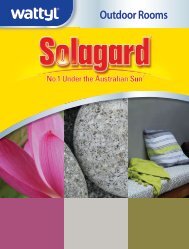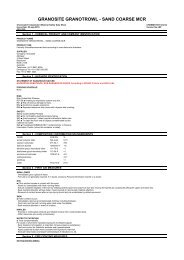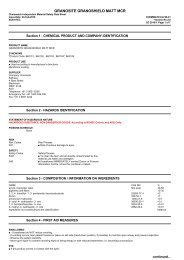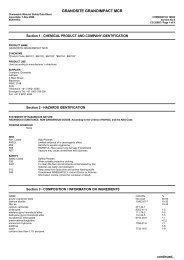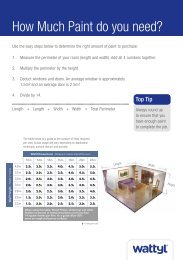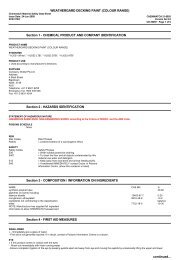Chemwatch MSDS Print - Wattyl
Chemwatch MSDS Print - Wattyl
Chemwatch MSDS Print - Wattyl
You also want an ePaper? Increase the reach of your titles
YUMPU automatically turns print PDFs into web optimized ePapers that Google loves.
Granosite GranoPrime 'S'<br />
Hazard Alert Code: MODERATE<br />
<strong>Chemwatch</strong> Material Safety Data Sheet<br />
Issue Date: 24-Nov-2010 CHEMWATCH 5042-01<br />
X9317SP<br />
Version No:8<br />
Page 1 of 9<br />
Section 1 - CHEMICAL PRODUCT AND COMPANY IDENTIFICATION<br />
PRODUCT NAME<br />
Granosite GranoPrime 'S'<br />
PROPER SHIPPING NAME<br />
PAINT<br />
PRODUCT USE<br />
Used according to manufacturer's directions.<br />
The use of a quantity of material in an unventilated or confined space may result in increased exposure and an irritating<br />
atmosphere developing. Before starting consider control of exposure by mechanical ventilation.<br />
SUPPLIER<br />
Company: Granosite<br />
Address:<br />
4 Steel Street<br />
Blacktown<br />
NSW, 2148<br />
Australia<br />
Telephone: +61 2 9621 6255<br />
Emergency Tel:+61 1800 039 008<br />
Fax: +61 2 9831 4244<br />
Section 2 - HAZARDS IDENTIFICATION<br />
STATEMENT OF HAZARDOUS NATURE<br />
HAZARDOUS SUBSTANCE. DANGEROUS GOODS. According to the Criteria of NOHSC, and the ADG Code.<br />
RISK<br />
Risk Codes<br />
Risk Phrases<br />
R10<br />
• Flammable.<br />
R20<br />
• Harmful by inhalation.<br />
R36/37/38<br />
• Irritating to eyes, respiratory system and skin.<br />
R51/53 • Toxic to aquatic organisms, may cause long- term adverse<br />
effects in the aquatic environment.<br />
R65<br />
• HARMFUL- May cause lung damage if swallowed.<br />
R67<br />
• Vapours may cause drowsiness and dizziness.<br />
R21/22?<br />
• Skin contact and/or ingestion may produce health damage*.<br />
R33? • Cumulative effects may result following exposure*.<br />
R40(3)?<br />
• Limited evidence of a carcinogenic effect*.<br />
R61? • May be harmful to the foetus/ embryo*.<br />
R66? • Repeated exposure potentially causes skin dryness and<br />
cracking*.<br />
SAFETY<br />
Safety Codes<br />
S23<br />
S24<br />
S25<br />
S36<br />
S37<br />
S39<br />
S51<br />
S09<br />
S53<br />
S29<br />
S401<br />
Safety Phrases<br />
• Do not breathe gas/fumes/vapour/spray.<br />
• Avoid contact with skin.<br />
• Avoid contact with eyes.<br />
• Wear suitable protective clothing.<br />
• Wear suitable gloves.<br />
• Wear eye/face protection.<br />
• Use only in well ventilated areas.<br />
• Keep container in a well ventilated place.<br />
• Avoid exposure - obtain special instructions before use.<br />
• Do not empty into drains.<br />
• To clean the floor and all objects contaminated by this material, use water<br />
and detergent.<br />
continued...
Granosite GranoPrime 'S'<br />
Hazard Alert Code: MODERATE<br />
<strong>Chemwatch</strong> Material Safety Data Sheet<br />
Issue Date: 24-Nov-2010 CHEMWATCH 5042-01<br />
X9317SP<br />
Version No:8<br />
Page 2 of 9<br />
Section 2 - HAZARDS IDENTIFICATION<br />
S07<br />
S35<br />
S13<br />
S26<br />
S46<br />
S57<br />
S61<br />
S60<br />
• Keep container tightly closed.<br />
• This material and its container must be disposed of in a safe way.<br />
• Keep away from food, drink and animal feeding stuffs.<br />
• In case of contact with eyes, rinse with plenty of water and contact Doctor or<br />
Poisons Information Centre.<br />
• If swallowed, IMMEDIATELY contact Doctor or Poisons Information Centre. (show<br />
this container or label).<br />
• Use appropriate container to avoid environmental contamination.<br />
• Avoid release to the environment. Refer to special instructions/Safety data<br />
sheets.<br />
• This material and its container must be disposed of as hazardous waste.<br />
Section 3 - COMPOSITION / INFORMATION ON INGREDIENTS<br />
NAME CAS RN %<br />
aromatic solvent 100 Not avail. >60<br />
acrylic polymer Not avail. 20-40<br />
ingredients not contributing to the classification
Granosite GranoPrime 'S'<br />
Hazard Alert Code: MODERATE<br />
<strong>Chemwatch</strong> Material Safety Data Sheet<br />
Issue Date: 24-Nov-2010 CHEMWATCH 5042-01<br />
X9317SP<br />
Version No:8<br />
Page 3 of 9<br />
Section 4 - FIRST AID MEASURES<br />
intubated.<br />
• Arrhythmias complicate some hydrocarbon ingestion and/or inhalation and electrocardiographic evidence of myocardial injury has<br />
been reported; intravenous lines and cardiac monitors should be established in obviously symptomatic patients. The lungs<br />
excrete inhaled solvents, so that hyperventilation improves clearance.<br />
• A chest x-ray should be taken immediately after stabilisation of breathing and circulation to document aspiration and detect<br />
the presence of pneumothorax.<br />
Any material aspirated during vomiting may produce lung injury. Therefore emesis should not be induced mechanically or<br />
pharmacologically.<br />
Section 5 - FIRE FIGHTING MEASURES<br />
EXTINGUISHING MEDIA<br />
• Water spray or fog.<br />
• Alcohol stable foam.<br />
• Dry chemical powder.<br />
• Carbon dioxide.<br />
FIRE FIGHTING<br />
• Alert Fire Brigade and tell them location and nature of hazard.<br />
• May be violently or explosively reactive.<br />
• Wear breathing apparatus plus protective gloves.<br />
• Prevent, by any means available, spillage from entering drains or water course.<br />
FIRE/EXPLOSION HAZARD<br />
• Liquid and vapour are flammable.<br />
• Moderate fire hazard when exposed to heat or flame.<br />
• Vapour forms an explosive mixture with air.<br />
• Moderate explosion hazard when exposed to heat or flame.<br />
Combustion products include: carbon monoxide (CO), carbon dioxide (CO2), other pyrolysis products typical of burning organic<br />
material.<br />
Contains low boiling substance: Closed containers may rupture due to pressure buildup under fire conditions.<br />
May emit clouds of acrid smoke.<br />
FIRE INCOMPATIBILITY<br />
• Avoid contamination with oxidising agents i.e. nitrates, oxidising acids, chlorine bleaches, pool chlorine etc. as ignition may<br />
result.<br />
HAZCHEM<br />
•3Y<br />
Section 6 - ACCIDENTAL RELEASE MEASURES<br />
MINOR SPILLS<br />
• Remove all ignition sources.<br />
• Clean up all spills immediately.<br />
• Avoid breathing vapours and contact with skin and eyes.<br />
• Control personal contact with the substance, by using protective equipment.<br />
MAJOR SPILLS<br />
• Clear area of personnel and move upwind.<br />
• Alert Fire Brigade and tell them location and nature of hazard.<br />
• May be violently or explosively reactive.<br />
• Wear breathing apparatus plus protective gloves.<br />
Personal Protective Equipment advice is contained in Section 8 of the <strong>MSDS</strong>.<br />
continued...
Granosite GranoPrime 'S'<br />
Hazard Alert Code: MODERATE<br />
<strong>Chemwatch</strong> Material Safety Data Sheet<br />
Issue Date: 24-Nov-2010 CHEMWATCH 5042-01<br />
X9317SP<br />
Version No:8<br />
Page 4 of 9<br />
Section 7 - HANDLING AND STORAGE<br />
PROCEDURE FOR HANDLING<br />
• Electrostatic discharge may be generated during pumping - this may result in fire.<br />
• Ensure electrical continuity by bonding and grounding (earthing) all equipment.<br />
• Restrict line velocity during pumping in order to avoid generation of electrostatic discharge (
Granosite GranoPrime 'S'<br />
Hazard Alert Code: MODERATE<br />
<strong>Chemwatch</strong> Material Safety Data Sheet<br />
Issue Date: 24-Nov-2010 CHEMWATCH 5042-01<br />
X9317SP<br />
Version No:8<br />
Page 5 of 9<br />
Section 8 - EXPOSURE CONTROLS / PERSONAL PROTECTION<br />
for xylenes:<br />
IDLH Level: 900 ppm<br />
Odour Threshold Value: 20 ppm (detection), 40 ppm (recognition)<br />
NOTE: Detector tubes for o-xylene, measuring in excess of 10 ppm, are available commercially. (m-xylene and p-xylene give<br />
almost the same response).
Granosite GranoPrime 'S'<br />
Hazard Alert Code: MODERATE<br />
<strong>Chemwatch</strong> Material Safety Data Sheet<br />
Issue Date: 24-Nov-2010 CHEMWATCH 5042-01<br />
X9317SP<br />
Version No:8<br />
Page 6 of 9<br />
Section 9 - PHYSICAL AND CHEMICAL PROPERTIES<br />
APPEARANCE<br />
Acrylic polymer solutions may contain residual traces of odourous acrylic monomers; the amounts remaining in compounded mixtures<br />
represents a very low order of exposure, however this may become noticeable with some materials particularly in confined or<br />
poorly ventilated spaces.<br />
Transparent with a white flammable liquid with a solvent odour; not<br />
miscible with water.<br />
PHYSICAL PROPERTIES<br />
Liquid.<br />
Does not mix with water.<br />
Floats on water.<br />
State Liquid Molecular Weight Not Applicable<br />
Melting Range (°C) Not Available Viscosity Not Available<br />
Boiling Range (°C) 150- 170 Solubility in water (g/L) Immiscible<br />
Flash Point (°C) 41- 43 pH (1% solution) Not Applicable<br />
Decomposition Temp (°C) Not Available pH (as supplied) Not Applicable<br />
Autoignition Temp (°C) 465 Vapour Pressure (kPa) Not Available<br />
Upper Explosive Limit (%) 7.0 Specific Gravity (water=1) 0.91<br />
Lower Explosive Limit (%) 0.6 Relative Vapour Density >1<br />
(air=1)<br />
Volatile Component (%vol) >60 Evaporation Rate Not Available<br />
Section 10 - STABILITY AND REACTIVITY<br />
CONDITIONS CONTRIBUTING TO INSTABILITY<br />
• Presence of incompatible materials.<br />
• Product is considered stable.<br />
• Hazardous polymerisation will not occur.<br />
For incompatible materials - refer to Section 7 - Handling and Storage.<br />
Section 11 - TOXICOLOGICAL INFORMATION<br />
POTENTIAL HEALTH EFFECTS<br />
ACUTE HEALTH EFFECTS<br />
SWALLOWED<br />
■ Accidental ingestion of the material may be damaging to the health of the individual.<br />
Ingestion of petroleum hydrocarbons can irritate the pharynx, oesophagus, stomach and small intestine, and cause swellings and<br />
ulcers of the mucous. Symptoms include a burning mouth and throat; larger amounts can cause nausea and vomiting, narcosis,<br />
weakness, dizziness, slow and shallow breathing, abdominal swelling, unconsciousness and convulsions. Damage to the heart muscle<br />
can produce heart beat irregularities, ventricular fibrillation (fatal) and ECG changes. The central nervous system can be<br />
depressed. Light species can cause a sharp tingling of the tongue and cause loss of sensation there. Aspiration can cause cough,<br />
gagging, pneumonia with swelling and bleeding.<br />
Considered an unlikely route of entry in commercial/industrial environments. The liquid may produce gastrointestinal discomfort<br />
and may be harmful if swallowed. Ingestion may result in nausea, pain and vomiting. Vomit entering the lungs by aspiration may<br />
cause potentially lethal chemical pneumonitis.<br />
EYE<br />
■ Evidence exists, or practical experience predicts, that the material may cause eye irritation in a substantial number of<br />
individuals. Prolonged eye contact may cause inflammation characterised by a temporary redness of the conjunctiva (similar to<br />
windburn).<br />
The liquid may produce eye discomfort and is capable of causing temporary impairment of vision and/or transient eye inflammation,<br />
ulceration.<br />
Direct eye contact with petroleum hydrocarbons can be painful, and the corneal epithelium may be temporarily damaged. Aromatic<br />
species can cause irritation and excessive tear secretion.<br />
continued...
Granosite GranoPrime 'S'<br />
Hazard Alert Code: MODERATE<br />
<strong>Chemwatch</strong> Material Safety Data Sheet<br />
Issue Date: 24-Nov-2010 CHEMWATCH 5042-01<br />
X9317SP<br />
Version No:8<br />
Page 7 of 9<br />
Section 11 - TOXICOLOGICAL INFORMATION<br />
SKIN<br />
■ Skin contact with the material may damage the health of the individual; systemic effects may result following absorption.<br />
Entry into the blood-stream, through, for example, cuts, abrasions or lesions, may produce systemic injury with harmful effects.<br />
Examine the skin prior to the use of the material and ensure that any external damage is suitably protected.<br />
The material may cause moderate inflammation of the skin either following direct contact or after a delay of some time. Repeated<br />
exposure can cause contact dermatitis which is characterised by redness, swelling and blistering.<br />
Aromatic hydrocarbons may produce sensitivity and redness of the skin. They are not likely to be absorbed into the body through<br />
the skin but branched species are more likely to.<br />
INHALED<br />
■ If exposure to highly concentrated solvent atmosphere is prolonged this may lead to narcosis, unconsciousness, even coma and<br />
possible death.<br />
Inhalation of aerosols (mists, fumes), generated by the material during the course of normal handling, may be harmful.<br />
The material can cause respiratory irritation in some persons. The body's response to such irritation can cause further lung<br />
damage.<br />
Inhalation hazard is increased at higher temperatures.<br />
Acute effects from inhalation of high vapour concentrations may be chest and nasal irritation with coughing, sneezing, headache<br />
and even nausea.<br />
Inhaling high concentrations of mixed hydrocarbons can cause narcosis, with nausea, vomiting and lightheadedness. Low molecular<br />
weight (C2-C12) hydrocarbons can irritate mucous membranes and cause incoordination, giddiness, nausea, vertigo, confusion,<br />
headache, appetite loss, drowsiness, tremors and stupor. Massive exposures can lead to severe central nervous system depression,<br />
deep coma and death. Convulsions can occur due to brain irritation and/or lack of oxygen. Permanent scarring may occur, with<br />
epileptic seizures and brain bleeds occurring months after exposure. Respiratory system effects include inflammation of the lungs<br />
with oedema and bleeding. Lighter species mainly cause kidney and nerve damage; the heavier paraffins and olefins are especially<br />
irritant to the respiratory system. Alkenes produce pulmonary oedema at high concentrations. Liquid paraffins may produce<br />
sensation loss and depressant actions leading to weakness, dizziness, slow and shallow respiration, unconsciousness, convulsions<br />
and death. C5-7 paraffins may also produce multiple nerve damage. Aromatic hydrocarbons accumulate in lipid rich tissues<br />
(typically the brain, spinal cord and peripheral nerves) and may produce functional impairment manifested by nonspecific symptoms<br />
such as nausea, weakness, fatigue, vertigo; severe exposures may produce inebriation or unconsciousness. Many of the petroleum<br />
hydrocarbons can sensitise the heart and may cause ventricular fibrillation, leading to death.<br />
CHRONIC HEALTH EFFECTS<br />
■ Substance accumulation, in the human body, may occur and may cause some concern following repeated or long-term occupational<br />
exposure.<br />
There has been some concern that this material can cause cancer or mutations but there is not enough data to make an assessment.<br />
There is some evidence from animal testing that exposure to this material may result in toxic effects to the unborn baby.<br />
Chronic solvent inhalation exposures may result in nervous system impairment and liver and blood changes. [PATTYS].<br />
TOXICITY AND IRRITATION<br />
■ The material may be irritating to the eye, with prolonged contact causing inflammation. Repeated or prolonged exposure to<br />
irritants may produce conjunctivitis.<br />
The material may cause skin irritation after prolonged or repeated exposure and may produce on contact skin redness, swelling,<br />
the production of vesicles, scaling and thickening of the skin.<br />
Asthma-like symptoms may continue for months or even years after exposure to the material ceases. This may be due to a nonallergenic<br />
condition known as reactive airways dysfunction syndrome (RADS) which can occur following exposure to high levels of<br />
highly irritating compound.<br />
Section 12 - ECOLOGICAL INFORMATION<br />
Toxic to aquatic organisms, may cause long-term adverse effects in the aquatic environment.<br />
This material and its container must be disposed of as hazardous waste.<br />
Avoid release to the environment.<br />
Refer to special instructions/ safety data sheets.<br />
Ecotoxicity<br />
Ingredient Persistence: Persistence: Air Bioaccumulation Mobility<br />
Water/Soil<br />
aromatic solvent 100 No Data No Data<br />
Available<br />
Available<br />
acrylic polymer No Data No Data<br />
Available<br />
Available<br />
continued...
Granosite GranoPrime 'S'<br />
Hazard Alert Code: MODERATE<br />
<strong>Chemwatch</strong> Material Safety Data Sheet<br />
Issue Date: 24-Nov-2010 CHEMWATCH 5042-01<br />
X9317SP<br />
Version No:8<br />
Page 8 of 9<br />
Section 13 - DISPOSAL CONSIDERATIONS<br />
• Recycle wherever possible.<br />
• Consult manufacturer for recycling options or consult local or regional waste management authority for disposal if no suitable<br />
treatment or disposal facility can be identified.<br />
• Dispose of by: burial in a land-fill specifically licenced to accept chemical and / or pharmaceutical wastes or Incineration in<br />
a licenced apparatus (after admixture with suitable combustible material).<br />
• Decontaminate empty containers. Observe all label safeguards until containers are cleaned and destroyed.<br />
• Containers may still present a chemical hazard/ danger when empty.<br />
• Return to supplier for reuse/ recycling if possible.<br />
Otherwise:<br />
• If container can not be cleaned sufficiently well to ensure that residuals do not remain or if the container cannot be used to<br />
store the same product, then puncture containers, to prevent re-use, and bury at an authorised landfill.<br />
• Where possible retain label warnings and <strong>MSDS</strong> and observe all notices pertaining to the product.<br />
Section 14 - TRANSPORTATION INFORMATION<br />
Labels Required: FLAMMABLE LIQUID<br />
HAZCHEM:<br />
•3Y (ADG7)<br />
Land Transport UNDG:<br />
Class or division: 3 Subsidiary risk: None<br />
UN No.: 1263 UN packing group: III<br />
Shipping Name:PAINT (including paint, lacquer, enamel, stain, shellac,<br />
varnish, polish, liquid filler and liquid lacquer base)<br />
Air Transport IATA:<br />
ICAO/IATA Class: 3 ICAO/IATA Subrisk: None<br />
UN/ID Number: 1263 Packing Group: III<br />
Special provisions:<br />
A3<br />
Cargo Only<br />
Packing Instructions: 366 Maximum Qty/Pack: 220 L<br />
Passenger and Cargo<br />
Passenger and Cargo<br />
Packing Instructions: 355 Maximum Qty/Pack: 60 L<br />
Passenger and Cargo Limited Quantity<br />
Passenger and Cargo Limited Quantity<br />
Packing Instructions: Y344 Maximum Qty/Pack: 10 L<br />
Shipping name:PAINT<br />
Maritime Transport IMDG:<br />
IMDG Class: 3 IMDG Subrisk: None<br />
UN Number: 1263 Packing Group: III<br />
EMS Number: F-E,S-E Special provisions: 163 223 955<br />
Limited Quantities: 5 L Marine Pollutant: Yes<br />
Shipping name:PAINT<br />
Section 15 - REGULATORY INFORMATION<br />
POISONS SCHEDULE<br />
S5<br />
REGULATIONS<br />
Regulations for ingredients<br />
No data for Granosite GranoPrime 'S' (CW: 5042-01)<br />
No data for aromatic solvent 100 (CAS: , Not avail)<br />
No data for acrylic polymer (CAS: , Not avail)<br />
continued...
Granosite GranoPrime 'S'<br />
Hazard Alert Code: MODERATE<br />
<strong>Chemwatch</strong> Material Safety Data Sheet<br />
Issue Date: 24-Nov-2010 CHEMWATCH 5042-01<br />
X9317SP<br />
Version No:8<br />
Page 9 of 9<br />
Section 16 - OTHER INFORMATION<br />
■ Classification of the preparation and its individual components has drawn on official and authoritative sources as well as<br />
independent review by the <strong>Chemwatch</strong> Classification committee using available literature references.<br />
A list of reference resources used to assist the committee may be found at:<br />
www.chemwatch.net/references.<br />
■ The (M)SDS is a Hazard Communication tool and should be used to assist in the Risk Assessment. Many factors determine whether<br />
the reported Hazards are Risks in the workplace or other settings.<br />
This document is copyright. Apart from any fair dealing for the purposes of private study, research, review or<br />
criticism, as permitted under the Copyright Act, no part may be reproduced by any process without written<br />
permission from CHEMWATCH. TEL (+61 3) 9572 4700.<br />
Issue Date: 24-Nov-2010<br />
<strong>Print</strong> Date: 2-Aug-2012<br />
This is the end of the <strong>MSDS</strong>.


